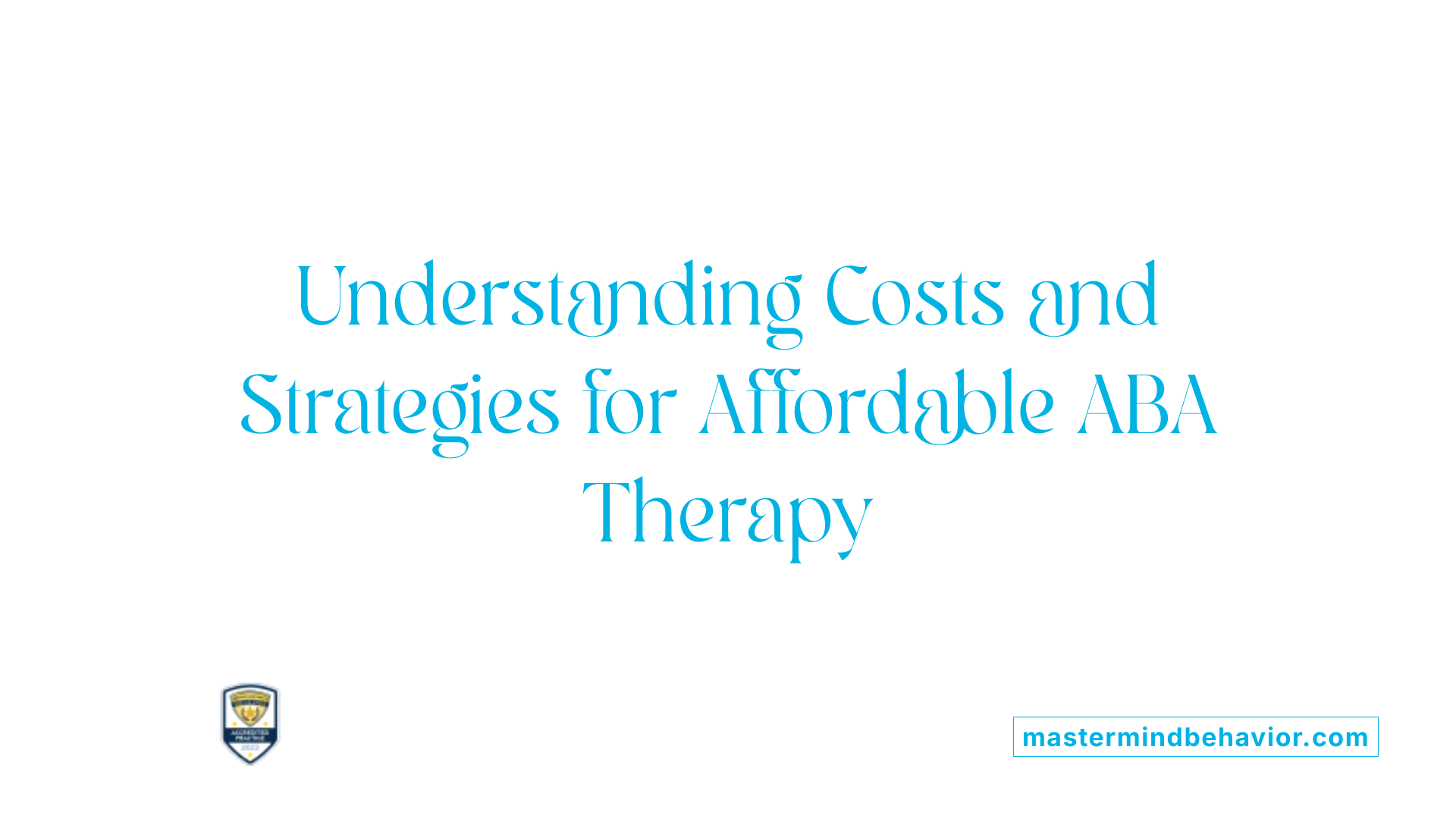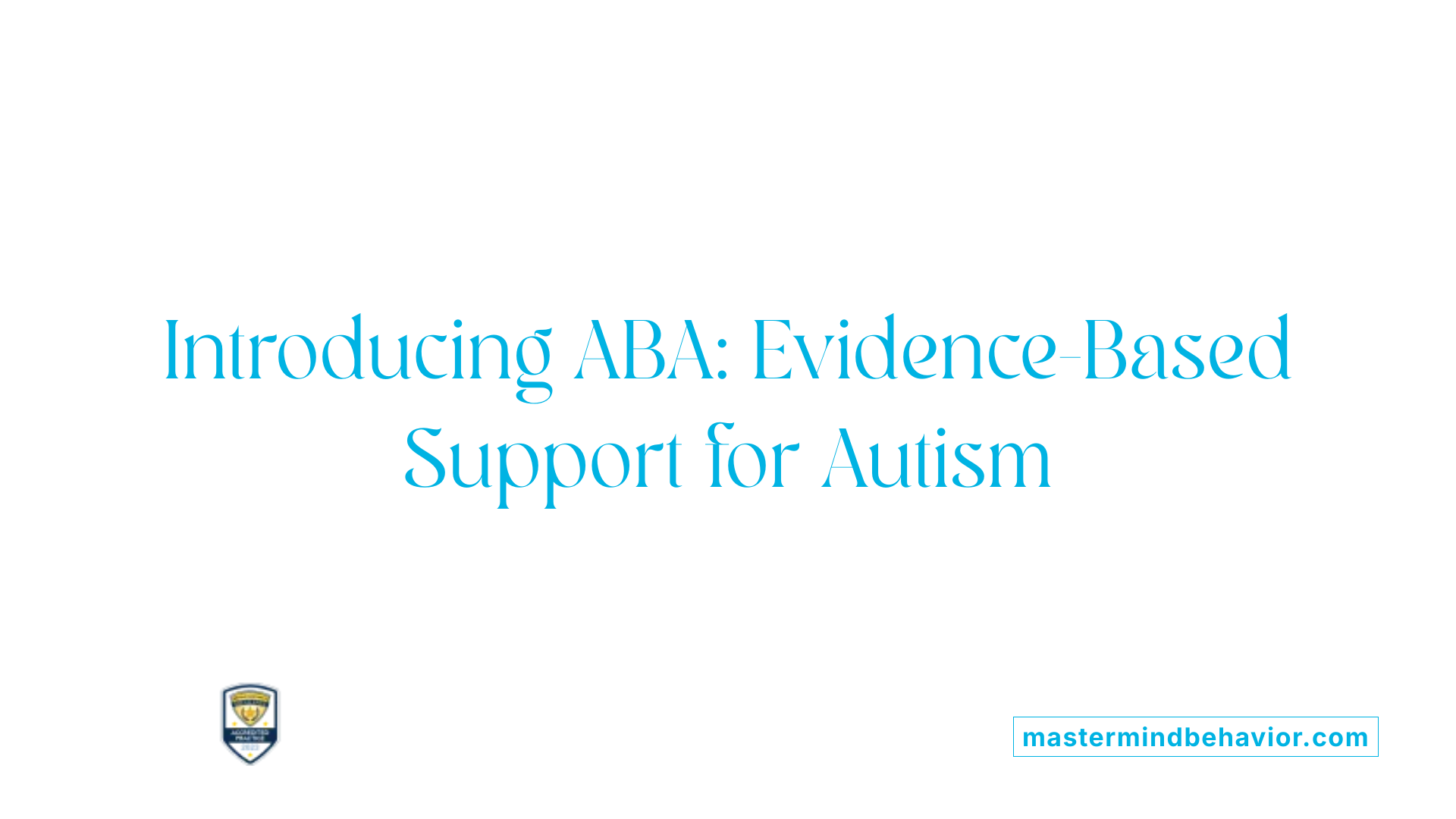Understanding ABA Therapy and Financial Challenges
Applied Behavior Analysis (ABA) therapy is an evidence-based intervention crucial for supporting individuals with autism spectrum disorder (ASD). As families seek effective treatment to improve communication, social skills, and daily living activities, the financial cost and insurance navigation become significant concerns. This article explores the types of ABA therapy available, the associated costs, and strategic approaches for securing financial aid and insurance coverage to make therapy accessible and sustainable.
Key Facts List: Intensive ABA Therapy and Insurance
- Intensive ABA therapy is highly structured, individualized, and designed to meet specific needs of individuals with ASD.
- Costs vary based on therapist qualifications, session duration, location, and customization of treatment plans.
- Long-term costs are significant due to multi-year commitment, ongoing evaluations, and potential support services.
- Families can manage costs through researching providers, insurance benefits, payment plans, and group therapy options.
- Early intervention maximizes developmental improvements, potentially reducing long-term costs and increasing independence.
- Community resources like grants, scholarships, and nonprofit aid can help offset therapy expenses.
- Insurance coverage for ABA varies but is often recognized as medically necessary for autism treatment, depending on state laws and policy details.
- Key insurance terms such as deductibles, copayments, and pre-authorization influence out-of-pocket costs and access to services.
- Advocacy strategies include documentation, early pre-authorization requests, appeals, and support networks to maximize benefits.
- Understanding provider networks, coverage limits, and state mandates helps families navigate and optimize insurance benefits for ABA therapy.
1. Intensive, Individualized ABA Therapy: Costs and Financial Strategies

What is the nature and structure of intensive ABA therapy?
Applied Behavior Analysis (ABA) therapy is a science-based approach focused on understanding behavior and its environmental influences. Intensive ABA therapy is highly structured and individualized, crafted to meet the unique skills, interests, and needs of individuals with Autism Spectrum Disorder (ASD). Such therapy involves carefully designed programs created by Board Certified Behavior Analysts (BCBAs) and executed with the help of trained therapists, often Registered Behavior Technicians (RBTs).
The emphasis of intensive ABA is on systematically increasing beneficial behaviors and reducing harmful or disruptive ones. Goals typically span communication, social skills, self-care, play, motor skills, and academics. Intensive programs involve frequent and long sessions lasting several years to produce meaningful and lasting developmental improvements.
Which factors influence the cost of intensive ABA therapy?
Costs of ABA therapy vary widely based on several critical factors:
- Therapist qualifications: BCBAs, due to specialized education and certification, typically command higher hourly rates compared to less specialized clinicians.
- Session length and frequency: Intensive programs require more hours per week, directly increasing costs.
- Geographical location: Urban centers often have higher rates due to demand and living costs.
- Customization level: Highly individualized treatment plans tailored to a person's specific needs may incur greater expenses.
How do the long-term cost implications arise?
ABA therapy is often a multi-year commitment. While initial intensive sessions are costly, the gradual progress allows for reduction in hours or transitioning to maintenance phases over time. Despite these adjustments, cumulative costs can be significant due to:
- Duration spanning several years to achieve substantial skill acquisition.
- Need for ongoing evaluations and treatment plan updates.
- Potential incorporation of additional support services.
Families should anticipate the total projected costs upfront to prepare financially.
What strategies help families manage the high costs of ABA therapy?
Managing intensive ABA therapy’s financial demands requires careful planning and resourcefulness. Common strategies include:
- Researching providers: Comparing costs, qualifications, and services among multiple ABA providers.
- Insurance exploration: Verifying coverage policies, pre-authorization requirements, and in-network providers.
- Payment plans: Negotiating flexible payment options directly with therapy providers.
- Group therapy options: Participating in group sessions where appropriate, which may reduce per-session costs.
Combining these approaches can make therapy more affordable without sacrificing quality.
What is the role of comprehensive financial planning?
Beyond immediate cost control, families benefit from strategic financial preparedness that includes:
- Special needs trusts: Protecting assets and ensuring funds dedicated to therapy.
- Estate planning: Securing future care and financial resources.
- Government benefits: Leveraging programs like Medicaid, Social Security Disability Insurance (SSDI), or Supplemental Security Income (SSI).
- Tax deductions: Utilizing eligible tax breaks related to medical expenses.
Such planning increases financial security and sustains therapy over the long term.
Why is early intervention important for long-term outcomes?
Starting ABA therapy early maximizes developmental improvements across communication, social behavior, academics, and daily living. Early intervention can reduce the intensity and duration of therapy needed later, effectively lowering cumulative costs and enhancing quality of life. This proactive approach often leads to greater independence and better educational and vocational opportunities.
How do community resources support families financially?
Several external financial resources can ease the burden of ABA therapy costs:
- Grants: Organizations and foundations offering monetary assistance for therapy expenses.
- Scholarships: Funding targeted at families pursuing specialized interventions.
- Nonprofit aid programs: Services providing subsidized therapy or financial counseling.
- Community support networks: Groups sharing knowledge on funding opportunities and emotional support.
Families actively engaging these resources often gain critical assistance to sustain therapy.
| Aspect | Description | Impact on Families |
|---|---|---|
| Therapist Qualifications | BCBAs charge higher rates due to expertise | Increased upfront cost but higher quality care |
| Session Frequency & Duration | More hours yield higher costs | Requires long-term financial planning |
| Location | Urban vs rural pricing differences | May influence provider selection |
| Customization Level | Individually tailored treatment plans | Enhances effectiveness, possibly increases cost |
| Financial Strategies | Insurance, payment plans, group therapy | Helps offset high expenses |
| Early Intervention | Starting therapy early | Improves outcomes, may reduce total therapy cost |
| Community Resources | Grants, scholarships, nonprofit aid | Provides supplementary financial support |
| Comprehensive Financial Planning | Trusts, estate plans, tax benefits | Secures funding and protects assets |
2. Insurance Coverage and Advocacy for ABA Therapy: Navigating Complex Systems

Overview of Insurance Coverage for ABA Therapy
Insurance coverage for Applied Behavior Analysis (ABA) therapy varies across commercial insurance plans and Medicaid, but many payers recognize ABA as a medically necessary treatment for autism spectrum disorder (ASD). Both private insurers and Medicaid often cover ABA therapy when prescribed appropriately and when certain conditions such as diagnosis verification and pre-authorization are met. However, the extent of coverage depends on state regulations, the insurance plan details, and the individual’s eligibility.
State Mandates Affecting Insurance Coverage for ASD Treatments
Several states have enacted laws mandating insurance coverage for ASD treatments, including ABA therapy. States like California, Massachusetts, and New York require health insurance providers to cover ABA for individuals diagnosed with ASD. These mandates ensure that families have access to essential therapy services without prohibitive costs. Nonetheless, each state's law varies concerning age limits, types of services covered, and policy specifics, so families must familiarize themselves with their state regulations.
Key Insurance Terms Parents Should Understand
Navigating insurance benefits involves understanding important terms that influence out-of-pocket expenses and access to services:
- Deductibles: The amount families must pay out-of-pocket before insurance coverage begins. This can impact when ABA therapy benefits take effect.
- Copayments: Fixed fees for each therapy session or visit that families are responsible for paying.
- Pre-authorization (Prior Authorization): Insurance companies often require approval before granting coverage for ABA services. This involves submitting documentation such as diagnosis and treatment plans.
- Network Types: Insurance plans may restrict coverage to providers within their network, making it important to select therapists who accept the family's insurance.
Grasping these terms helps families anticipate costs and plan accordingly.
Steps to Verify Coverage
Families should take a proactive approach in verifying their ABA therapy coverage to avoid unexpected expenses or service denials:
- Contact Insurance Providers Directly: Speak with customer service representatives to obtain detailed explanations of ABA benefits, including session limits, coverage criteria, and financial responsibilities.
- Review Policy Documents: Thoroughly read the plan’s summary of benefits and coverage to understand included services, exclusions, and limitations.
- Understand Provider Networks: Confirm that the intended ABA providers, especially Board Certified Behavior Analysts (BCBAs) and Registered Behavior Technicians (RBTs), participate in the insurance network to ensure maximum coverage.
This comprehensive verification reduces surprises during therapy.
Role of Major Private Insurers in ABA Coverage
Leading insurance companies such as Cigna, Blue Cross Blue Shield, Kaiser Permanente, and Aetna provide varying degrees of coverage for ABA therapy. These insurers typically require pre-authorization and adherence to clinical guidelines developed for ASD treatments. While coverage is often robust with these companies, families should still confirm session limits, copays, and any deductibles applicable to their plan. Choosing in-network providers also enhances financial benefits and streamlines claim processing.
Impact of Insurance Limits and Requirements on Therapy Access
Insurance policies often place boundaries on ABA therapy access, such as session limits per year, caps on total reimbursable costs, or requirements for ongoing clinical evaluations to renew authorization. These restrictions can affect the intensity and duration of treatment families can afford. Understanding these limits helps families anticipate when they may need to supplement therapy costs or advocate for additional services.
Advocacy Tips for Families to Maximize Insurance Benefits
Families can employ several strategies to advocate effectively and reduce financial burden:
- Documentation is Crucial: Keep detailed records of diagnoses, therapy plans, progress notes, and correspondence with insurers to support claims.
- Request Pre-Authorization Early: Submit required documentation well in advance to avoid service interruptions.
- Negotiate Payment Plans or Sliding Scales: Some providers may offer financial accommodations based on family circumstances.
- Explore Government and Non-Profit Supports: Coordinate ABA therapy funding with grants, scholarships, and community resources.
- Appeal Denials: When coverage is denied, families have the right to file appeals, providing additional medical information or clarifications to insurers.
- Join Support Groups and Advocacy Networks: Connecting with other families can share insights about maximizing coverage and navigating common challenges.
Through persistence and informed negotiation, families can improve access to ABA services while managing costs effectively.
What is Applied Behavior Analysis (ABA) therapy and how is it used to support individuals with autism?

Definition and Scientific Basis of ABA Therapy
Applied Behavior Analysis (ABA) therapy is a science-based approach that studies how behavior works and its relation to the environment. This method helps individuals with autism by increasing helpful behaviors and reducing harmful or disruptive ones. ABA relies on the principles of learning and behavior modification validated by extensive research.
Individualized Nature and Key Therapeutic Goals
Each ABA program is tailored to the unique needs, skills, interests, and family circumstances of the individual. Qualified professionals known as Board Certified Behavior Analysts (BCBAs) design these personalized programs. The therapy focuses on improving communication, social skills, self-care, play, motor skills, and academic abilities.
Common Techniques Such as Positive Reinforcement and A-B-C Analysis
ABA therapy uses positive reinforcement to encourage desirable behaviors. It also applies the A-B-C (Antecedent-Behavior-Consequence) framework to analyze and modify behavior effectively. This approach helps therapists understand why behaviors occur and how to promote positive change.
Settings and Scope of ABA Therapy
ABA sessions can take place in various environments including the home, school, and community. Therapy can be structured or embedded in natural settings, ensuring that skills are generalized across different contexts. This flexibility supports the individual's growth in daily life activities and social integration.
Evidence Supporting Intensive Early Intervention Benefits
Research strongly supports early and intensive ABA therapy, often involving 25 to 40 hours per week over one to three years, producing significant improvements in intellectual functioning, language, daily living skills, and social abilities. Early intervention is crucial, leading to lasting developmental benefits and greater independence.
Who provides ABA therapy and what qualifications do these professionals typically have?

Roles of Board Certified Behavior Analysts (BCBAs) and Registered Behavior Technicians (RBTs)
ABA therapy is primarily provided by a team that includes Board Certified Behavior Analysts (BCBAs) and Registered Behavior Technicians (RBTs). BCBAs are the lead professionals who design, implement, and oversee individualized ABA programs. They analyze behaviors and determine the best strategies to help improve communication, social skills, and daily living activities.
RBTs work directly with individuals receiving therapy, implementing treatment plans as supervised by BCBAs. They are responsible for carrying out daily therapy sessions and recording data on progress.
Certification and education requirements for each provider category
To become a BCBA, a professional must typically hold a graduate degree in behavior analysis or a related field, complete supervised fieldwork hours, and pass a rigorous certification exam. This education ensures that BCBAs have the expertise to design specialized interventions tailored to each individual's needs.
RBTs require at least 40 hours of training in ABA techniques and must pass a certification exam. This training equips them to implement therapy safely and effectively under BCBA supervision.
Function and responsibilities in ABA delivery and supervision
BCBAs hold responsibility for creating treatment goals, supervising therapy sessions, training RBTs, and continuously monitoring and adjusting interventions to maximize effectiveness. RBTs deliver the day-to-day therapy sessions, support data collection, and communicate observations to BCBAs.
Additional credentials (BCaBAs, BCBA-Ds) and their contributions
Other important professionals include Board Certified Assistant Behavior Analysts (BCaBAs), who have undergraduate degrees and complete supervised experience. BCaBAs assist BCBAs in developing and revising programs but must work under BCBA supervision.
Doctoral-level BCBAs (BCBA-Ds) hold the highest credential in the field, combining doctoral education with BCBA certification. They often lead research, provide advanced clinical supervision, and contribute to training and policy development.
Together, this multidisciplinary team ensures ABA therapy is delivered with expertise and adherence to evidence-based practices, benefiting individuals with autism and related developmental challenges.
What are the key benefits and challenges associated with ABA therapy for autism?

What improvements does ABA therapy offer for individuals with autism?
ABA therapy provides a range of benefits for individuals with autism spectrum disorder (ASD). It enhances communication skills, helping children express needs and engage with others more effectively. Social skills development is another major benefit, allowing children to build relationships and improve interactions in varied settings like home, school, and community. Additionally, ABA supports language development, attention, focus, and academic performance, promoting independence in daily living activities.
What scientific evidence supports the effectiveness of ABA therapy?
There is substantial scientific support for ABA’s effectiveness. Research demonstrates improved intellectual functioning, language acquisition, daily living skills, and social functioning among children receiving ABA therapy. Techniques such as positive reinforcement and careful analysis of behavior antecedents, behaviors, and consequences (often known as A-B-Cs) help tailor interventions to individual needs, increasing the likelihood of meaningful and lasting progress.
What are the main challenges associated with ABA therapy?
Despite its benefits, ABA therapy presents several challenges. The therapy usually requires a major time commitment, often ranging from 20 to 40 hours per week over multiple years. This intensity can place a heavy demand on families' schedules and resources. Financially, the costs can be high, particularly for long-term, intensive programs, and may require navigating varying insurance coverage policies, out-of-pocket expenses, or finding alternative funding.
Are there challenges related to insurance and provider availability?
Insurance coverage for ABA therapy varies significantly by policy and state, and families often face challenges understanding coverage limits, deductibles, copayments, and pre-authorization requirements. Qualified provider availability can also be scarce in some regions, making access to experienced Board Certified Behavior Analysts (BCBAs) and Registered Behavior Technicians (RBTs) complicated.
What are the overall goals of ABA therapy?
ABA aims to foster meaningful progress in communication, social participation, self-care, play skills, and academic abilities. By increasing helpful behaviors and reducing harmful or disruptive ones, ABA promotes greater independence, educational opportunities, vocational success, and social integration, improving overall quality of life for individuals with autism and their families.
Maximizing Access to ABA Therapy Through Financial and Insurance Support
Families seeking ABA therapy for autism face complex financial and insurance landscapes, but understanding available resources and strategies can make accessing this vital intervention more feasible. Comprehensive financial planning, exploring government grants, nonprofit support, and community resources are key strategies to manage costs of intensive ABA programs. Equally important is navigating insurance coverage with knowledge of policy details, state mandates, and insurer requirements, alongside proactive advocacy to maximize benefits. By combining financial aid approaches with insurance savvy, families can sustain long-term ABA therapy, promoting independence and improved quality of life for individuals with autism.
References
- Costs of ABA Therapy: Expenses, Options, and Financial ...
- Insurance Coverage in ABA Therapy - Autism Treatment
- Applied Behavior Analysis (ABA)
- What to Consider When Looking for a Qualified ABA Provider
- Applied Behavior Analysis (ABA)
- Types Of ABA Therapy Jobs And Their Degree Requirements
- Applied Behavior Analysis (ABA)
- The Controversy Around ABA
- 6 Benefits of ABA Therapy for Children with Autism
- The Top 10 Reasons Children With Autism Deserve ABA









